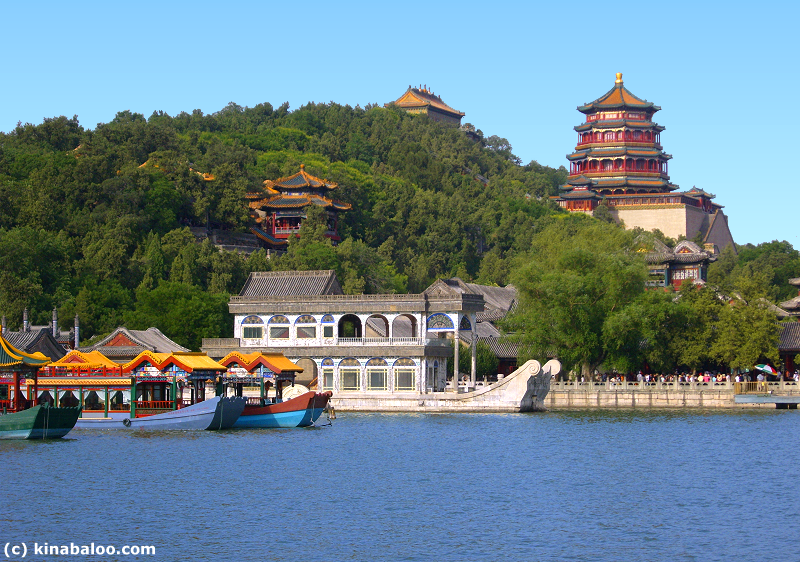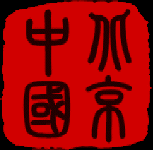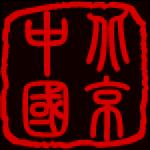Introduction to the Summer Palace  The Summer Palace is located on the western edge of Beijing, between the fourth and fifth ring roads, close to the western Fragrant Hills, 12km from central Beijing. The simplest way to arrive is by subway. Station BeiGongMen (North Palace Gate, line 4) is right by the north gate entrance, close to the Four Great Regions temple and SuZhou Street. It is not expensive to get there by taxi and does not take long. Use a map to tell the driver you want to be taken to the north gate if you would like to follow our suggested route through the park, or ask your hotel receptionist to add 'north gate' to 'Summer Palace' written in Chinese script on a piece of paper to show the taxi driver. As its name implies, the Summer Palace was used as a summer residence by China's imperial rulers - as a retreat from the main imperial palace now known as the Palace Museum (or 'Forbidden City') - a pleasure-ground in the countryside, yet near to the city.  The Summer Palace is virtually a museum of traditional Chinese garden arts that blends rocks, trees, pavilions, lakes, ponds, paths and other features to create a poetic effect between different scenes. As you meander around the Summer Palace, you will frequently find the vista changing. This Summer Palace guide looks at its history, presents a clear map with a suggested route through the palace grounds, and looks at each place of interest in detail. The guide contains 400 superb photographs that both illustrate each location, and hint at the beauty of the gardens as a whole. Discover the Summer Palace ... A brief history of the Summer Palace The gardens that became the Summer Palace date from the Jin Dynasty (1115-1234). Later, the Mongol Emperor Kublai Khan (Yuan Dynasty, 1279-1368), who wanted to improve Beijing's water supply, ordered the construction of canals to transport water from the Western Hills to the Summer Palace. He also enlarged the main lake (now called KunMing Lake) to act as a reservoir. In 1750, Emperor QianLong (1736-1796) of the Qing Dynasty (1644-1911), who travelled extensively throughout China noting places of beauty, added substantially to the gardens of the Summer Palace. He appointed designers to reproduce the styles of various palaces and gardens from around China. For example, KunMing Lake was extended to imitate the famous West Lake in HangZhou. 
In 1860, the Anglo-French Allied Forces invaded Beijing and set fire to many of the buildings within the Summer Palace.  In 1886, Dowager Empress CiXi, with embezzled funds from the Imperial Navy, restored the grand gardens. The reconstruction and enlargement of the Summer Palace continued for ten years and included the Marble Boat. After completion of the renovation, CiXi renamed the gardens 'YiHeYuan' ('Garden of Peace and Harmony'), its official name today. The Empress Dowager CiXi moved her administration to the renovated YiHeYuan in 1889 and the gardens that had long been an imperial pleasure ground became the primary Summer Palace. Tales of CiXi's excesses (including the Marble Boat) are numerous and came to symbolise the decadence of the imperial family.  The Summer Palace is sometimes referred to as the 'New Summer Palace'. The original primary Summer Palace (YuanMingYuan, and now also known as the 'Old Summer Palace') was demolished in 1860 by invading Anglo-French forces. Then, shortly after, the eight allied powers invaded in 1900 during the Boxer Rebellion to plunder and destroy the newly reconstructed New Summer Palace. Only when the fugitive CiXi returned to Beijing in 1903, did full-scale restoration begin. In this way, the Summer Palaces - both old and new - are also associated in popular culture with the destructive interference of foreign powers. Today's Summer Palace is more or less the same as the palace rebuilt from 1903.  After the success of the 1911 Republican Revolution, the Summer Palace was opened to the public. Then, after the last Qing Emperor PuYi was thrown out of the Forbidden City in 1924, the Summer Palace was turned into a park, which has become a popular and relaxing destination for both domestic and international tourists. The park can be historically divided into three parts, namely : administration, residence and scenery browsing area. The administration area, taking in the Halls of Benevolence and Longevity as its principal part, is where the Qing dynasty's dowager empress CiXi dealt with state affairs and received officials. The residence area mainly consists of the Hall of Jade Billows, the Garden of Virtue and Harmony, and the Hall of Joyful Longevity. Kunming Lake, Longevity Hill and betond form the scenery browsing area. Longevity Hill is an augmented hill based on an offshoot of the Western Fragrant Hills. Earth and rocks removed to enlarge the lakes and waterways was used to boost the hill.
The Summer Palace Today  After the Great Wall and the Forbidden City, the Summer Palace is the next 'must see' place to visit for any tourist. Indeed, the author has been there over 100 times and every visit has been special. Because of its size and the desire to linger in each place, a whole day is recommended for your visit. For a small fee plus deposit you can take your own small boat out onto the lake - to relax and enjoy a different view of these wonderful gardens. The Summer Palace was designated a World Heritage site by UNESCO in 1990. The halls, pavilions, bridges and temples, Kunming Lake and Longevity Hill, all blend together harmoniously in spite of their individual styles. Ingeniously conceived and elaborately designed, the Summer Palace, featuring the garden styles of both northern and southern China, is justifiably known as the 'garden of gardens'. Indeed, the Summer Palace represents a quintessentially Chinese ideal of harmony between man and nature.
Videos of the Summer Palace
[kvideo v=wqwYXgrMoTU w=640] [kvideo v=qX8q5DGLkso w=640] [kvideo v=GwkeXf7Xzxw w=640]
| 










